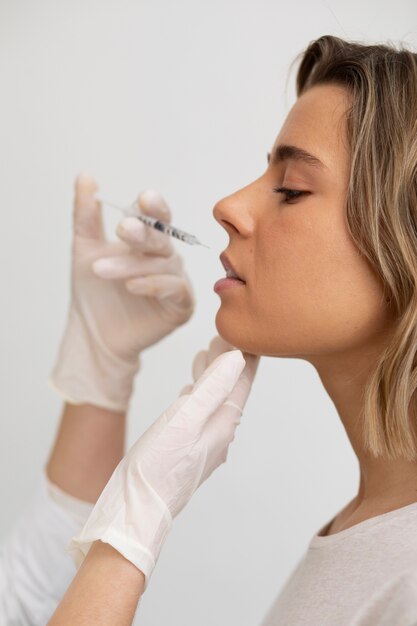Lip Augmentation Abu Dhabi has become a popular cosmetic procedure for those seeking fuller, more youthful lips. While many patients enjoy satisfying results, it’s essential to understand the risks and considerations associated with the procedure. In this article, we will explore the different types of lip augmentation, potential complications, and tips for minimizing risks to ensure a safe and positive experience.
1. Understanding Lip Augmentation
Lip augmentation involves enhancing the size and shape of the lips, often through the use of dermal fillers, fat grafting, or surgical implants. The choice of method can significantly impact the results, longevity, and potential risks involved.
1.1 Types of Lip Augmentation
- Dermal Fillers: The most common method, using substances like hyaluronic acid to add volume and shape.
- Fat Grafting: Involves harvesting fat from another area of the body and injecting it into the lips.
- Lip Implants: Permanent implants can be placed in the lips to create a fuller appearance.

2. Potential Risks and Complications
While many patients experience satisfactory results from lip augmentation, it’s crucial to be aware of potential risks. Understanding these can help you make informed decisions and discuss any concerns with your provider.
2.1 Allergic Reactions
One of the primary risks associated with dermal fillers is the potential for allergic reactions. Some patients may react negatively to the filler material, leading to swelling, redness, or discomfort.
2.2 Infection
Any procedure involving injections carries a risk of infection. Proper sterilization techniques and aftercare are essential to minimize this risk.
2.3 Asymmetry and Uneven Results
Achieving perfectly symmetrical lips can be challenging. There may be instances where one lip appears fuller or shaped differently than the other, leading to dissatisfaction with the results.
3. Short-Term Side Effects
In addition to the more severe risks, patients may experience short-term side effects that can be bothersome but are generally temporary.
3.1 Swelling and Bruising
Post-procedure swelling and bruising are common after lip augmentation. These effects can last for several days but typically resolve without intervention.
3.2 Pain and Discomfort
Mild pain or discomfort is also expected after the procedure. Over-the-counter pain relievers are often sufficient to manage these sensations.
4. Long-Term Considerations
Understanding the long-term implications of lip augmentation is vital for anyone considering the procedure.
4.1 Filler Longevity and Repeated Treatments
Most dermal fillers are not permanent and require maintenance treatments to sustain results. Regular touch-ups can lead to increased costs and potential cumulative risks.
4.2 Changes in Lip Structure
Over time, repeated injections can alter the natural structure of the lips. This change may lead to an unnatural appearance or difficulties in future procedures.
5. Choosing a Qualified Practitioner
The importance of selecting a qualified and experienced practitioner cannot be overstated. A skilled provider can help minimize risks and ensure the best possible outcomes.
5.1 Research Credentials and Experience
When considering lip augmentation, take the time to research potential providers. Look for qualifications, experience, and reviews from previous patients to gauge their proficiency.
5.2 Open Communication
During consultations, ensure open communication about your goals and concerns. A reputable practitioner will take the time to understand your desires and educate you about the procedure, including potential risks.
6. Pre-Procedure Preparations
Taking appropriate steps before your lip augmentation can help reduce risks and enhance your experience.
6.1 Consultation and Assessment
A thorough consultation should include an assessment of your medical history, an examination of your lips, and a discussion of your goals. This will help your practitioner determine the most suitable approach.
6.2 Avoiding Certain Medications
Certain medications and supplements, such as blood thinners, can increase the risk of bruising and bleeding. Your practitioner may advise you to avoid these before the procedure.
7. Aftercare Tips for Minimizing Risks
Proper aftercare is crucial for minimizing risks and ensuring a smooth recovery.
7.1 Follow Post-Procedure Instructions
Follow any aftercare instructions provided by your practitioner meticulously. This may include avoiding strenuous activities, excessive heat, or certain skincare products for a specified period.
7.2 Monitor for Complications
Keep an eye on your lips for any signs of complications, such as increased swelling, prolonged pain, or unusual discoloration. Contact your practitioner immediately if you notice anything concerning.
8. Conclusion
While lip augmentation can enhance facial aesthetics and boost confidence, it is essential to be aware of the associated risks. By understanding the potential complications, preparing adequately, and choosing a qualified practitioner, you can make informed decisions and minimize risks. Ultimately, knowledge is key to achieving satisfying results while maintaining safety.
FAQs
1. What are the most common risks associated with lip augmentation?
Common risks include allergic reactions, infection, asymmetry, swelling, and bruising.
2. How long do the results of lip fillers last?
The effects of lip fillers typically last from six months to a year, depending on the type of filler used.
3. Can I have lip augmentation if I have a history of cold sores?
Yes, but it’s crucial to inform your practitioner, as they may recommend antiviral medication to reduce the risk of outbreaks.
4. Are there any permanent lip augmentation options?
Yes, lip implants are a permanent option, but they come with their own set of risks and considerations.
5. How can I minimize swelling after lip augmentation?
Applying ice packs and following your practitioner’s aftercare instructions can help reduce swelling.
6. Is lip augmentation suitable for everyone?
While many people are suitable candidates, it’s essential to have a consultation to assess your individual health and aesthetic goals.
7. What should I do if I experience complications after the procedure?
Contact your practitioner immediately if you notice any unusual symptoms or complications. Early intervention can help address issues effectively.


